
Learn how brave women fought for the right to vote and won 100 years ago.
- Subject:
- History
- U.S. History
- Material Type:
- Lesson
- Author:
- Laura Town
- Williamstown Communications
- Karen Hoffman
- Date Added:
- 08/18/2022

Learn how brave women fought for the right to vote and won 100 years ago.
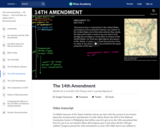
Jeffrey Rosen of the National Constitution Center in conversation with Walter Isaacson of the Aspen Institute. Created by Aspen Institute.
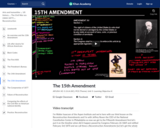
Jeffrey Rosen of the National Constitution Center in conversation with Walter Isaacson of the Aspen Institute. Created by Aspen Institute.

Author: Daniel Shogan, Danville Museum of Fine Arts and History Students will learn about the 1883 Massacre in Danville, Virginia as an example of racist mob violence against African Americans. Within the context of the massacre, they will be shown primary documents from the event. These documents will provide the students with not only a lens into the Danville of the nineteenth century, but also provide them with an opportunity to think critically about the biases present in some of the documents. After careful discussion of the events and outcomes of the massacre, the students will be given vocabulary worksheets that help to define and underline the most important elements of the narrative.

This course is a continuation of 24.951. This semester the course topics of interest include movement, phrase structure, and the architecture of the grammar.
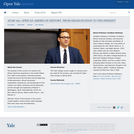
The purpose of this course is to examine the African American experience in the United States from 1863 to the present. Prominent themes include the end of the Civil War and the beginning of Reconstruction; African Americans' urbanization experiences; the development of the modern civil rights movement and its aftermath; and the thought and leadership of Booker T. Washington, Ida B. Wells-Barnett, W.E.B. Du Bois, Marcus Garvey, Martin Luther King Jr., and Malcolm X. WARNING: Some of the lectures in this course contain graphic content and/or adult language that some users may find disturbing.

In this lesson students learn about the Reconstruction Amendments (13th, 14th and 15th) that abolished slavery, guaranteed African American citizenship and secured men the right to vote.

American Government is designed to meet the scope and sequence requirements of the single-semester American government course. This title includes innovative features designed to enhance student learning, including Insider Perspective features and a Get Connected Module that shows students how they can get engaged in the political process. The book provides an important opportunity for students to learn the core concepts of American government and understand how those concepts apply to their lives and the world around them. American Government includes updated information on the 2016 presidential election.Senior Contributing AuthorsGlen Krutz (Content Lead), University of OklahomaSylvie Waskiewicz, PhD (Lead Editor)

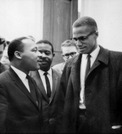

This course examines the social, cultural, political, and economic history of the United States, from the Civil War to the present. It uses secondary analysis and primary documents, such as court cases, personal accounts, photographs, and films, to examine some of the key issues in the shaping of modern America, including industrialization and urbanization, immigration, the rise of a mass consumer society, the emergence of the US as a global power, and the development of civil rights activism and other major social movements.

In this learning experience, the students will complete a primary source inquiry into the impacts of Reconstruction on Black experiences in Virginia and the South. The students will use the Claim-Evidence-Reasoning structure to defend one of two claims.Students will analyze sources that depict/detail Black experiences and perspectives before, during, and after the Reconstruction. This learning experience will be most effective after students have been introduced to the what and when of Reconstruction.

A puzzling caricature, probably dealing with Reconstruction under Andrew Johnson's administration. The work is quite crudely drawn. An acrobat, with mustache and sideburns and wearing a jester's cap, holds in each hand a mask, one grinning and one frowning. His legs stretch from the head of Pennsylvania congressman Thaddeus Stevens, who holds a paper labeled "Committee of 15" and is seated on a black man, who crawls on all fours, to the head of an unidentified man (probably Johnson) who holds the U.S. Constitution. The latter's back is turned to the viewer and several geese, some alive and some dead, appear at his feet. Stevens, an abolitionist, was one of the most prominent members of the Joint Committee on Reconstruction, composed of fifteen members of Congress. The fool remarks, "As yet, I have found no difficulty in standing upon my own platform."|Entered according to Act of Congress June 8th 1866.|Title appears as it is written on the item.|Weitenkampf, p. 153.|Forms part of: American cartoon print filing series (Library of Congress)|Published in: American political prints, 1766-1876 / Bernard F. Reilly. Boston : G.K. Hall, 1991, entry 1866-3.

Deputy U.S. Marshal Bass Reeves was a highly respected and wildly successful peace officer in Indian Territory for over thirty years, starting when he was first commissioned by federal Judge Isaac Parker in 1875. His life saw the enormous transformations that swept through the country during the Civil War, the days of the “wild west” in the federal territories, and the final settling of the frontier. The exploits of Deputy Marshal Reeves as he fought and captured hundreds of outlaws made him famous in his own time. This lesson tells the story of Reeves, his world, and his relentless pursuit of justice. The Woodson Center's Black History and Excellence curriculum is based on the Woodson Principles and tells the stories of Black Americans whose tenacity and resilience enabled them to overcome adversity and make invaluable contributions to our country. It also teaches character and decision-making skills that equip students to take charge of their futures. These lessons in Black American excellence are free and publicly available for all.
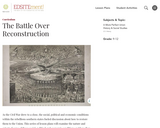
This curriculum unit of three lessons examines the social, political and economic conditions of the southern states in the aftermath of the Civil War and shows how these factors helped to shape the Reconstruction debate as well as the subsequent history of American race relations.

Online OER text created for U.S. History 1865 to Present by Dr. June Klees for Bay College.
© 2017 Bay College and Content Creators. Except where otherwise noted this work is licensed under the Creative Commons Attribution 4.0 International License. To view a copy of this license, visit http://creativecommons.org/licenses/by/4.0/.

The Cathedral of Notre-Dame, Paris, begun 1163 (recorded before the fire). speakers: Dr. Beth Harris and Dr. Steven Zucker. Created by Beth Harris and Steven Zucker.
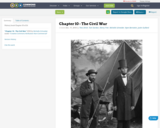
History book Chapter 10 of 26
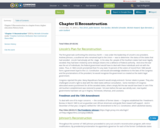
Chapter 11 Reconstruction is a chapter from a higher education History book.
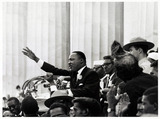
These anthologies parallel and supplement the OYH school modules, available as Open Education Resources. Groups of all ages can explore & discuss these collections. Also available through the OYH website, https://www.ownyourhistory.us/multimediaresourcesThis anthology focuses on the strategies and methods used in the 1960s by Black Americans to challenge Jim Crow segregation and to put equal rights and opportunities on the nation’s agenda. They called into question the subordination of Blacks and other people of color based upon racist views. Young, new leaders undertook nonviolent direct-action protests supported by Black religious organizations and studentsin the face of determined opposition and violence by Southern Whites. By 1965, the federal government responded by passing historic civil rights and voting rights legislation.These landmark accomplishments did not address economic inequalities. Urban uprisings in 1967-68 were fueled by these economic inequalities and the assassination of Dr. King. President Johnson appointed a commission led Otto Kerner to examine these uprisings and make recommendations.